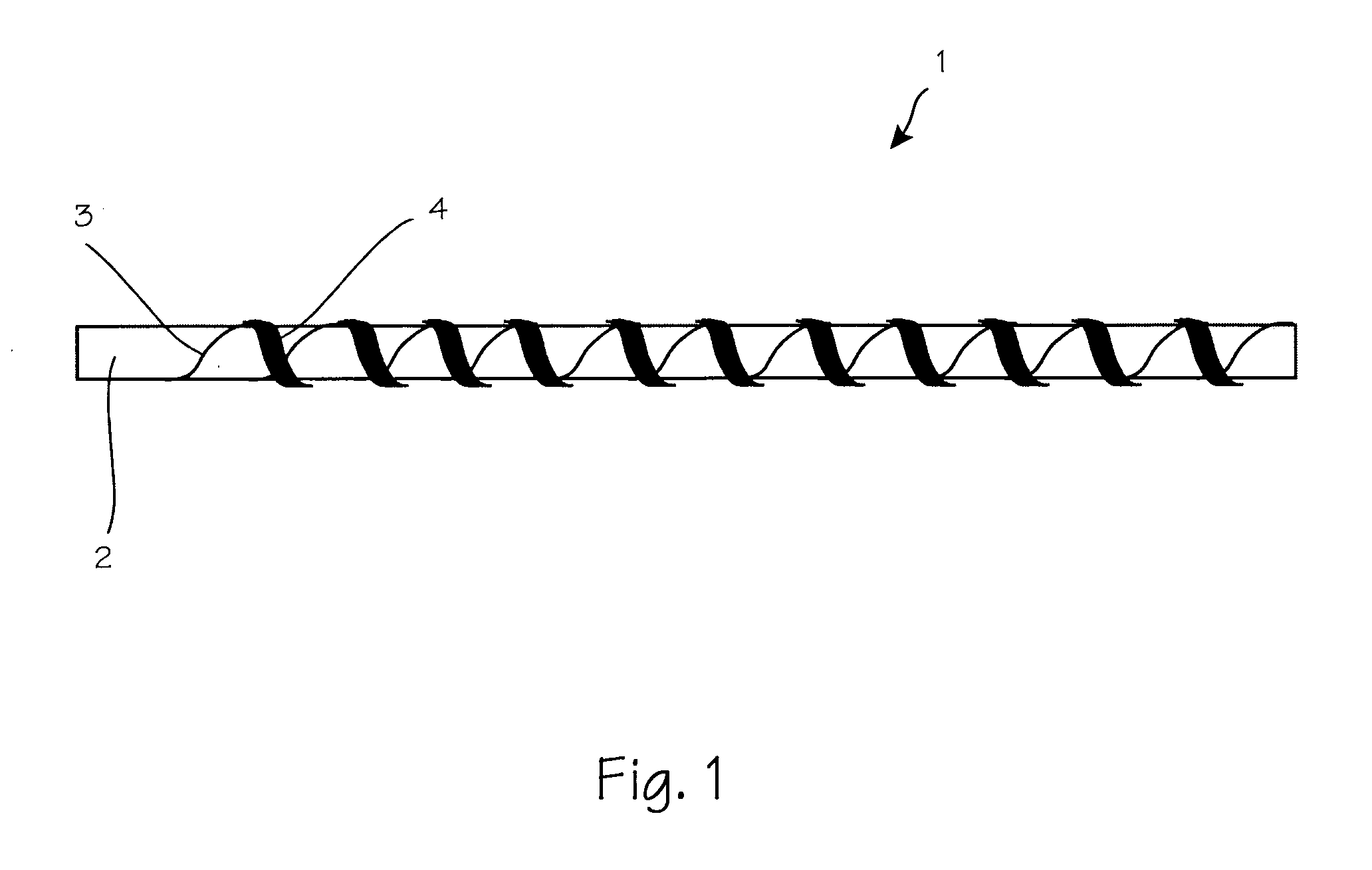Electrically conductive yarn
a technology of electrically conductive yarns and yarns, which is applied in the direction of yarns, heating element materials, heating element shapes, etc., can solve the problems of comparatively rigid yarns, difficult to produce fabrics on looms, and little optical resemblance to textiles and/or metallicity,
- Summary
- Abstract
- Description
- Claims
- Application Information
AI Technical Summary
Benefits of technology
Problems solved by technology
Method used
Image
Examples
example 1
[0047] An elastic thread of LYCRA® elastane yarn (dtex / type: 1880 dtex, Type T-163C) manufactured by DuPont® is pre-drawn on a yarn winding machine. The elongation at break of the thread is 500%, with a tear strength of 1300 cN. After elongation of 100%, the thread relaxes except for a permanent elongation of 2.4%.
[0048] The pre-drawn LYCRA® thread is passed through a hollow spindle. This hollow spindle carries a conical yarn spindle from which a 0.04 mm thick, hard silver-plated copper wire is drawn off overend by the LYCRA® thread. Silver / Copper Textile wire with TW-D coating manufactured by Elektro-Feindraht AG may be used. The diameter of this wire including its lacquer coating measures about 0.048 mm. The wire also exhibits an elongation at break of 21.3%.
[0049] The single-wire-enwound LYCRA® is passed through a second hollow spindle. This hollow spindle carries a commercially available multifilament polyamide (PA) yarn of PA66 with 78 dtex and 34 individual filaments. PA66 m...
example 2
[0051] The elastic, electrically conducting composite yarn in example 1 is employed as the weft thread on a commercially available power loom. The warp beam is composed of 0.3 mm thick, single-twisted cotton threads combined in groups of 8 threads. When interwoven, a firm fabric is created that possesses excellent electrical conductivity in the weft direction, and that does not conduct the electric current in the direction of the warp. These electrical properties are retained even after elongation by more than 120% in the weft direction. If the poles of a direct current voltage source are connected, spaced apart in the warp direction, this voltage can be used, at a distance of one meter in the weft direction, to operate an electrical sink, such as a light-emitting diode. The fabric can be stretched in the weft direction with no impact on the power supply of the light-emitting diode.
example 3
[0052] The elastic, electrically conducting composite yarn in example 1 is employed as the weft thread on a commercially available power loom. The warp beam is composed of an electrically conducting but not rubber elastic composite yarn. To manufacture the warp thread, a commercially available polyester yarn with 100 dtex and 36 individual filaments is furnished with an inner wrapping of 0.041 mm thick, hard silver-plated copper wire and an outer wrapping of commercially available polyamide yarn (PA66) with 78 dtex and 34 individual filaments.
[0053] When interwoven, a firm fabric is created that possesses excellent electrical conductivity in the weft direction and an electrical conductivity in the direction of the warp thread independent from the one in the weft direction. These electrical properties are retained even after elongation by more than 120% in the weft direction. This fabric, which is economical to produce, can, with suitable electronic activation, be employed as a matr...
PUM
| Property | Measurement | Unit |
|---|---|---|
| elongation at break | aaaaa | aaaaa |
| elastic elongation | aaaaa | aaaaa |
| elastic elongation | aaaaa | aaaaa |
Abstract
Description
Claims
Application Information
 Login to View More
Login to View More - R&D
- Intellectual Property
- Life Sciences
- Materials
- Tech Scout
- Unparalleled Data Quality
- Higher Quality Content
- 60% Fewer Hallucinations
Browse by: Latest US Patents, China's latest patents, Technical Efficacy Thesaurus, Application Domain, Technology Topic, Popular Technical Reports.
© 2025 PatSnap. All rights reserved.Legal|Privacy policy|Modern Slavery Act Transparency Statement|Sitemap|About US| Contact US: help@patsnap.com


